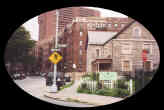Historical Facts and Pictures by Charles
Located just South of Gun Hill Road at Putnam Place and East of Bainbridge
Avenue at Van Cortlandt Avenue East is the park known as Williamsbridge Reservoir
Oval. Originally it had been a functioning reservoir that provided water to
the North Bronx from the end of the 19th Century until it was no longer needed
and was drained in 1925. Later the area was converted into a park with upper
and lower promenades, a field for sports activities, a track and playgrounds.
|
|
At the North of the reservoir a Keeper's House was constructed in 1889-90 in
an L-shaped, 2 1/2 story design, of rock-faced variegated grey-tan gneiss
ashlar with smooth, speckled-grey granite trim, including keyed enframements. The
house stands at 3450 Putnam Place on Reservoir Oval East at Reservoir Place.
After the reservoir was no longer needed, the housed became a private residence
for five decades before being purchased by the not-for-profit Mosholu
Preservationist Corporation in 1998. It was given landmark status two years
later.
|
|
Walk West along Reservoir Oval from Putnam Place and you'll soon come to
Bainbridge Avenue and East 208 Street, where the Bronx County Historical Society's
Museum of Bronx History is located at 3266 Bainbridge Avenue.
|
|
Primarily known as the Valentine-Varian House, this two-story fieldstone
farmhouse dates to 1758, the second oldest house in the borough. It's builder,
Isaac Valentine, was a blacksmith and farmer, who bought the original parcel of
land (the house long stood on the NW corner of Bainbridge Avenue and Van
Cortlandt Avenue East) from the Dutch Reformed Church. A sturdy structure, it was
constructed in a symmetrical style with identical chimneys at either end in a
style known as "Gregorian Vernacular," with evenly placed windows. Rooms in the
house to either side of the central hallway mirror each other in design.
Sections of the house still retain the original floorboards.
|
|
The house survived several fierce Revolutionary War battles with cannon
blasting from nearby hills. After the war, the Valentines reclaimed their house and
lived there until selling it to Isaac Varian in 1792, a successful butcher
and farmer. It remained in the possession of the Varian family for three
generations. One of Isaac's sons, also named Isaac, was the 63rd Mayor of New York
City from 1839-1841.
|
|
Sold at auction in 1905 to the Beller family, it was eventually donated to
the Bronx County Historical Society in 1965, where after it was removed across
Bainbridge Avenue to it's current location alongside the Reservoir Oval to make
way for an apartment complex (277 Van Cortlandt Avenue East).
|
|
The grounds around the Valentine-Varian House are graced with herb gardens,
fruit trees and a Civil War Memorial, the "Bronx River Soldier." This statue of
a Union infantryman had stood on a pedestal in the middle of the Bronx River
just South of Gun Hill Road for decades, until being removed and warehoused,
after years of neglect and weathering, during work on the Bronx River Parkway.
In 1968 the statue was rescued and then restored by a Woodlawn Cemetery
artisan, then the head of mausoleum repairs, the late Charles Augustoni. In 1970 The
Bronx River Soldier was given a place of distinction to the left of the
Valentine-Varian House, where he remains on guard today.
|
|
|
To the right of the Museum of Bronx History is the main tunnel entrance into
the Williamsbridge Reservoir Oval Park's lower-promenade, playgrounds, track and field. Inside there are a staircases to the tree-lined upper-promenade which
encircles the field, with many shaded park benches that offer relief from
Summer heat, and some interesting views of the surrounding Norwood neighborhood
|
|





















